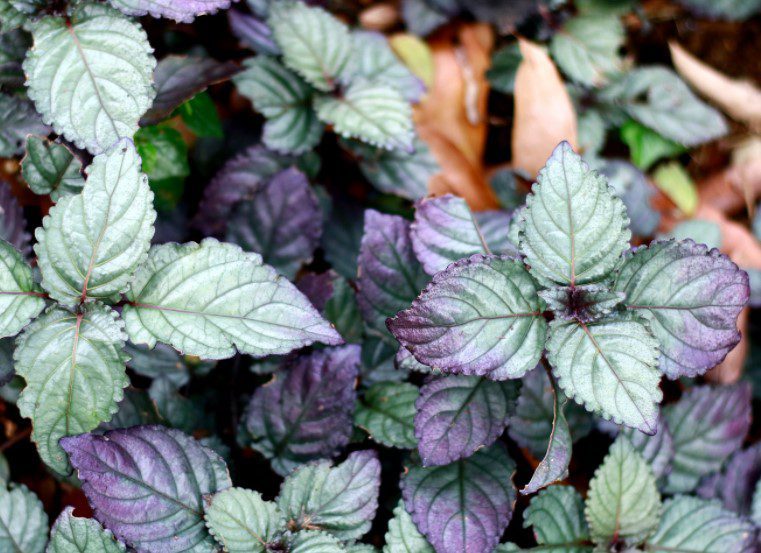Purple Waffle Plant
Hemigraphis alternata is also called the purple waffle plant. It makes a thick ground cover 4-6 inches high with wavy leaves with purple undersides.
Scientific name: Hemigraphis Alternata “Exotica.”
High light: Produces a rich purple color in the leaves when it is grown in bright sunlight. Lower light levels will not harm plants, but the leaves will turn a uniform green.
Water: Moisten the soil until it is dry to the touch. Higher humidity is better for growth.
Fertilizer: Provide fertilizer from spring to fall. You can skip winter feeding.
Propagation: Roots quickly from 4 to 6 tip cuttings that have been stuck in vermiculite.
Extra features: The “waffled” rich purple tinted foliage is dark green to purple at the top and always purplish beneath.
This makes it a great feature plant for your home or patio. The new growths initially stand upright but soon trail over the sides of the container. It is a good ground cover in the shade and its rich metallic green leaves, highlighted with deep wine red on the reverse, offer heaps of contrast.
Purple Waffle Plant Use
The purple waffle plant is an excellent color plant. It’s another old-fashioned plant that’s easy to grow indoors in a north- or east-facing exposure. Please put it in baskets and planters with other shade-loving plants with similar care requirements.
The purple waffle plant (hemigraphis alternata) is a short shrubby plant that prefers moist conditions and average indoor plant temperatures.
However, it will not tolerate cool weather and pout at temperatures below 16 degrees Celsius. As a result, it is not an excellent outdoor candidate for growing our climate.
When I put my houseplants out on the north patio, the waffle plant stays inside in the spring.
I can’t bring myself to run it in and out of the house whenever a cold front threatens.
The leaf has ripples on its surface and grows in a semi-upright position.
The name originates from the fact that it has a subtle but lovely purple color on the undersides of the leaves. The flowers will bloom, but they will be insignificant. The foliage provides the actual color.
If the plant lives in a small pot, watering can be difficult. It wilts quickly but responds well when repotted and watered. Repot into a loam-rich houseplant soil.
Remember the five-centimeter rule when repotting:
New pots should only be five centimeters larger than the previous pot. This permits the plant to dry out slightly between waterings.
I emphasize “moderately” for two reasons. First, the plant dislikes being too dry, and second, if kept constantly soaked, it will eventually suffer from root rot.
We easily reproduced the waffle plant from cuttings, which will remain attractive if regularly trimmed back. It forms a cushion of foliage with a gentle slope downwards as it matures. Keep it trimmed to avoid it becoming leggy.
Outside in summer, it grows in hanging baskets, containers, and moist soils in the ground, in full sun to part shade. And in June and July, it produces “flowers like baby’s breath, above the coarse, pebbly-looking foliage.
To keep the plant in shape, flowering stalks should be removed. The energy is channeled into the flowers; if the flower stalks are not removed, the plant can become unkempt.
Pests
Mealybugs On Purple Waffle
Mealybugs harm their host plants in a variety of ways. Removing sap or plant juices weakens the host plants, and the injection of a toxin in mealybug saliva causes distortion and yellowing, as well as flower and fruit drop.

Mealybugs also produce a lot of honeydew, sugary excrement that coats the stems, leaves, flowers, and fruit.
This sugary coating is ideal for the growth of a blackish sooty mold that degrades the plant’s appearance and, in large quantities, can inhibit photosynthesis.
Control
Mealybugs are difficult to eradicate. Mealybugs can be removed from houseplants using a cotton swab dipped in alcohol or fingernail polish remover.
You can also wash the insects away with a steady stream of water or wipe them out with a damp cloth. Keep an eye on the plant for a few weeks if any were missed.
Beware of spider mites and whiteflies on this plant; they appear the most troublesome. Usually, a good wash with plant soap once a month will get rid of these critters.
Purple waffle plants are an excellent addition to dish gardens or can be grown independently. Its roots do not grow too deeply, making it a perfect choice for low-sided dishes.
It makes an excellent centerpiece for a small table when combined with other moisture-loving plants.























